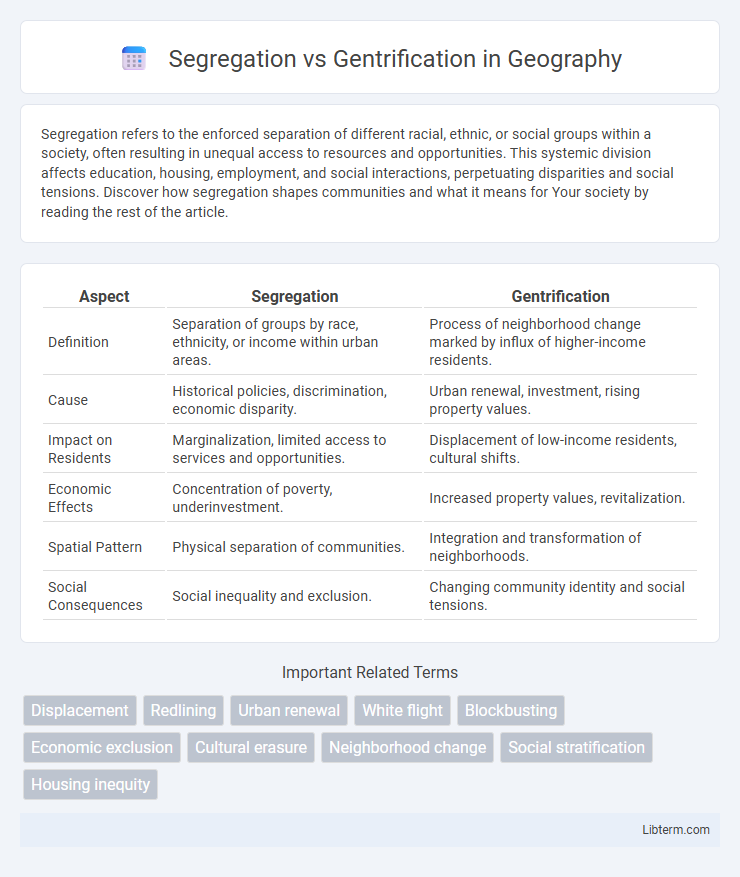Segregation refers to the enforced separation of different racial, ethnic, or social groups within a society, often resulting in unequal access to resources and opportunities. This systemic division affects education, housing, employment, and social interactions, perpetuating disparities and social tensions. Discover how segregation shapes communities and what it means for Your society by reading the rest of the article.
Table of Comparison
| Aspect | Segregation | Gentrification |
|---|---|---|
| Definition | Separation of groups by race, ethnicity, or income within urban areas. | Process of neighborhood change marked by influx of higher-income residents. |
| Cause | Historical policies, discrimination, economic disparity. | Urban renewal, investment, rising property values. |
| Impact on Residents | Marginalization, limited access to services and opportunities. | Displacement of low-income residents, cultural shifts. |
| Economic Effects | Concentration of poverty, underinvestment. | Increased property values, revitalization. |
| Spatial Pattern | Physical separation of communities. | Integration and transformation of neighborhoods. |
| Social Consequences | Social inequality and exclusion. | Changing community identity and social tensions. |
Understanding Segregation: Definition and Origins
Segregation refers to the systemic separation of groups based on race, ethnicity, or socioeconomic status, creating unequal access to resources and opportunities. Its origins trace back to historical policies such as redlining and discriminatory zoning laws that enforced racial and economic divides in residential patterns. Understanding these foundational mechanisms is essential to addressing the persistent disparities and social fragmentation linked to segregation.
What is Gentrification? Key Characteristics
Gentrification is an urban process where lower-income neighborhoods undergo transformation through an influx of more affluent residents, resulting in rising property values and displacement of original inhabitants. Key characteristics include renovation of dilapidated properties, increased investment in local infrastructure, and shifts in the cultural and socioeconomic fabric of the community. This phenomenon often leads to reduced affordable housing options and changes in neighborhood demographics.
Historical Context: Roots of Urban Segregation
Urban segregation originated in the early 20th century through racially restrictive covenants, redlining, and discriminatory lending practices that confined minority communities to specific neighborhoods. These policies institutionalized economic and social disparities, shaping city landscapes and access to resources. Gentrification later emerged as wealthier groups moved into these segregated areas, often displacing long-standing residents and altering the cultural fabric of urban spaces.
Drivers of Gentrification in Modern Cities
Urban renewal policies, rising property values, and increased demand for housing near economic hubs drive gentrification in modern cities. Investments in infrastructure, cultural amenities, and improved public services attract higher-income residents, often displacing lower-income communities. Real estate speculation and zoning changes further accelerate neighborhood transformation, reshaping urban demographics and economic landscapes.
Socioeconomic Impacts of Segregation
Segregation creates concentrated poverty by limiting access to quality education, healthcare, and employment opportunities, reinforcing systemic inequality in marginalized communities. It results in unequal resource distribution and diminished social mobility, perpetuating economic disparities across generations. The socioeconomic impact of segregation also includes increased crime rates and reduced public safety in affected neighborhoods, further hindering community development.
Gentrification’s Effects on Local Communities
Gentrification often leads to increased property values and living costs, displacing long-term, lower-income residents and altering the social fabric of neighborhoods. This process can stimulate economic development and improve infrastructure but frequently diminishes cultural diversity and exacerbates inequality. Local businesses may be replaced by upscale establishments, reducing accessibility for original community members and contributing to social exclusion.
Segregation vs Gentrification: Key Differences
Segregation involves the physical and social separation of groups based on race, ethnicity, or socioeconomic status, often resulting from historical policies and systemic discrimination. Gentrification refers to the process where urban neighborhoods experience an influx of wealthier residents, leading to rising property values and displacement of lower-income communities. Unlike segregation, which enforces division, gentrification transforms neighborhoods through economic shifts but can exacerbate social inequalities by displacing marginalized populations.
Overlapping Outcomes: Where Segregation and Gentrification Meet
Segregation and gentrification intersect in urban areas where both processes lead to increased displacement and socio-economic stratification. While segregation enforces racial or economic divides through systemic policies, gentrification often accelerates these divides by driving up property values and living costs, disproportionately affecting minority and low-income residents. The overlapping outcomes include reduced access to affordable housing, cultural erosion, and heightened community tensions.
Policy Responses to Segregation and Gentrification
Policy responses to segregation and gentrification emphasize equitable urban development through inclusionary zoning, affordable housing mandates, and anti-displacement measures. Municipal governments employ community land trusts and rent control policies to mitigate displacement risks and preserve socio-economic diversity in rapidly changing neighborhoods. Targeted investments in underserved areas promote access to quality education, healthcare, and transit, addressing systemic inequalities linked to segregation and unchecked gentrification.
Building Inclusive Neighborhoods: Pathways Forward
Segregation perpetuates social and economic divides by concentrating poverty and limiting access to resources, while gentrification often displaces long-standing residents through rising costs. Building inclusive neighborhoods requires policies that promote affordable housing, equitable economic development, and community engagement to preserve cultural identity and prevent displacement. Strategies such as inclusionary zoning, rent control, and investment in local infrastructure create pathways for diverse populations to coexist and thrive.
Segregation Infographic

 libterm.com
libterm.com